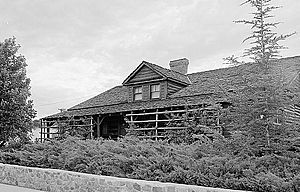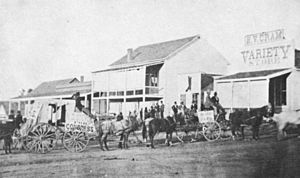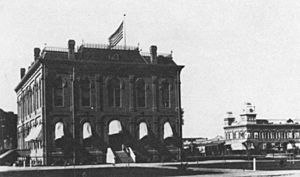Arizona Territory capitals facts for kids
The capital of the Arizona Territory changed four times over 25 years. It started in Prescott, moved to Tucson, then back to Prescott, and finally to Phoenix. These changes happened as the territory grew and political power shifted. Each move caused a lot of discussion and disagreement.
Contents
Why Did Arizona Need a Capital?
After the Gadsden Purchase in 1853, the New Mexico Territory became much larger. People started suggesting that the western part should become its own territory. This idea didn't happen for about ten years.
During the American Civil War, the southern part of the territory wanted to join the Confederate States of America. To prevent this, the United States Congress divided the territory. The western part became the Arizona Territory in 1863. This split helped keep the area under Union control.
Choosing the First Capital
The location of the new capital was a big debate right away. An early bill suggested Tucson in the south. However, the final law, signed by President Abraham Lincoln in 1863, did not name a capital city.
Territorial officials, including Governor John N. Goodwin, traveled to Arizona in 1863. They met General James Henry Carleton in New Mexico. Carleton advised against Tucson. He felt Tucson had too much Confederate and Mexican influence.
Carleton suggested a central location where a gold rush was happening. He had sent troops there to protect miners. They built Fort Whipple nearby. Governor Goodwin followed this advice and arrived at the fort in January 1864.
Goodwin soon decided the fort's location was too far from mining areas and timber. After a month, he explored the region. He chose to move Fort Whipple 14 miles south. He also decided to establish the capital two miles further south. This new spot became Prescott. General Carleton agreed to the move.
The 1st Arizona Territorial Legislature met in September 1864. They had the power to move the capital. Two other places were suggested: La Paz by the Colorado River, and Aztlan in central Arizona. But efforts to move the capital failed.
Tucson Becomes the Capital
Prescott remained the capital for several years. Then, in 1867, the 4th Arizona Territorial Legislature and Governor Richard Cunningham McCormick moved it to Tucson. This move was very controversial.
People in Prescott were angry. They accused some lawmakers of accepting unfair deals. They also claimed Governor McCormick supported the move to help his election to Congress. No proof of wrongdoing was found. The capital officially moved to Tucson on November 1, 1867.
Tucson was the most developed city in the territory. Many believed placing the capital there would help reduce Confederate influence in the south. In 1875, the 8th Arizona Territorial Legislature even voted to make Tucson the "permanent" capital.
Prescott's Second Chance as Capital
Tucson was the capital for only ten years. In 1877, the 9th Arizona Territorial Legislature voted to move it back to Prescott. This happened despite Tucson being named the "permanent" capital earlier. The move became effective on January 1, 1879.
Prescott had strong political power at this time. Yavapai County (where Prescott is) had twelve representatives. Pima County (where Tucson is) had only seven.
The location of the capital was still not settled. In 1879, the 10th Arizona Territorial Legislature considered moving it to Phoenix. Phoenix is in centrally-located Maricopa County. However, this idea did not pass.
Debates Over Location Continue
After the 1880 census, the number of representatives changed. Pima County had 16, Maricopa had 5, and Yavapai had 4. The 11th Arizona Territorial Legislature met in 1881 and discussed the capital again.
Prescott was a successful mining town. But it was far from the main population centers like Phoenix and Tucson. It was also hard to reach without a railroad. Its winters were harsh.
Bills were introduced to move the capital to Tucson, Phoenix, or the "geographical center" of the territory.
- Tucson argued it was ideal because it had a large population, mining wealth, and a railroad connection. It also had a good climate.
- Phoenix argued it was a rich farming area and was the population midpoint of the territory.
Prescott knew it needed support to keep the capital. The new town of Tombstone wanted to become its own county, Cochise County. Prescott and Tombstone representatives agreed to support each other. They also agreed to fight a bill that would remove a tax on mined ore. This tax brought a lot of money to their towns.
Cochise County was created with Prescott's support. However, the ore tax was repealed. A bill to move the capital to Tucson passed one house but failed in the other. The alliance between Prescott and Tombstone held strong. Ideas to let the people vote or let the U.S. Congress decide also failed.
In 1883, the 12th Arizona Territorial Legislature met. Another attempt to move the capital to Phoenix failed.
More Proposals and Deals
The 13th Arizona Territorial Legislature in 1885 again discussed the capital. Before the session, Tucson businessmen raised money to influence decisions and bring the capital back to Tucson.
An alliance of representatives met privately. They agreed to keep the capital in Prescott. In return, they would support other projects. People who wanted to move the capital pointed out that Prescott was hard to reach in winter. Sometimes, people from southern Arizona had to travel through Los Angeles to get there.
A railroad, the Prescott and Arizona Central Railway, was proposed. It would connect Prescott to a major railroad line. The legislature approved money to help build it. Prescott supporters hoped this railroad would make Prescott easier to reach and stop attempts to move the capital.
Tucson and Phoenix still wanted the capital. This legislature was giving money for many big projects. There were rumors of deals being made. For example, Tucson might support moving the capital to Phoenix if Tucson received a hospital for mental health.
In the end, Phoenix got the mental health hospital. A teachers college went to Tempe (near Phoenix). The territorial prison stayed in Yuma. A bridge was built in Florence. Tucson's newspaper suggested Tucson should get the territory university instead of the capital. A vote to move the capital to Tucson failed. The alliance members voted against it as they had promised.
The alliance also succeeded in other goals, like keeping the prison in Yuma. Finally, a bill established the University of Arizona in Tucson.
No Action in the Fourteenth Legislature
In 1887, the 14th Arizona Territorial Legislature took no action on the capital. Some important citizens in Tucson worried that another attempt to move the capital might hurt the new university. Also, Prescott now had a new railroad connection. Because of this, both Tucson newspapers suggested keeping the capital in Prescott.
However, a lawmaker from Maricopa County proposed moving the capital to Phoenix. A Prescott newspaper claimed this was just a trick to get more money for the mental health hospital. Some in Tucson felt Phoenix should be happy with the hospital and college. In the end, nothing happened.
Phoenix Becomes the Permanent Capital
By 1889, the political situation had changed. When the 15th Arizona Territorial Legislature met, the southern counties realized they could defeat Yavapai County if they worked together. The focus was on Phoenix.
Phoenix had a better climate and was closer to the main population centers. It also had a railroad connection. Supporters said Phoenix had better restaurants and hotels. Its City Hall also had space to temporarily house the government.
Phoenix tried to make deals with other areas. They offered support for things like more money for the Yuma prison and the Tucson university ($50,000). They also offered money, up to $10,000, to influence votes.
Prescott strongly opposed the move but had few ways to stop it. Prescott claimed Tucson only supported Phoenix to get revenge later. Prescott also said Phoenix was "buying" votes and the capital with territorial debt. They argued Prescott should keep the capital because Phoenix and Tucson had other public institutions. Prescott was also near the center of the territory and had better year-round weather than the desert summers of Phoenix.
Tucson supported the move to Phoenix. Tucson newspapers noted that the capital issue had caused "disturbing and corrupting" problems in politics. They felt it should be settled for good.
The legislature met in Prescott on January 22, 1889. Within days, they passed a bill to move the capital to Phoenix. They then adjourned and met again in Phoenix on February 7. Governor Zulick signed the bill on January 26. There were celebrations in Phoenix. Prescott newspapers claimed Phoenix had used bribery and accused Governor Zulick of being involved.
Prescott was even more upset because the move happened immediately. Usually, such a move would wait until the next legislature. Despite the complaints, Phoenix became Arizona's fourth and final capital.
Fun Legends About the Capital Move
There are some fun stories about the 1889 vote to move the capital to Phoenix. One popular legend says that the group wanting to move the capital had a one-vote lead in the House. A delegate named Charlie Warren from Bisbee supposedly swallowed his glass eye by mistake. He refused to appear in public without it, which would have kept the capital in Prescott. The story says a friend lent him an eye, and he then cast the tie-breaking vote for Phoenix.
This story isn't true. There was no Charlie Warren in the legislature. Also, the vote was not a tie (it was 13–9 and 9–2 in the two chambers).
Another version of the story says the lawmaker was from Yavapai County. In this tale, a woman swallowed the eye at the request of lawmakers from Maricopa County. The delegate, whose vote was needed to keep the capital in Prescott, refused to appear. This caused the bill to pass and the capital to move to Phoenix.
|




